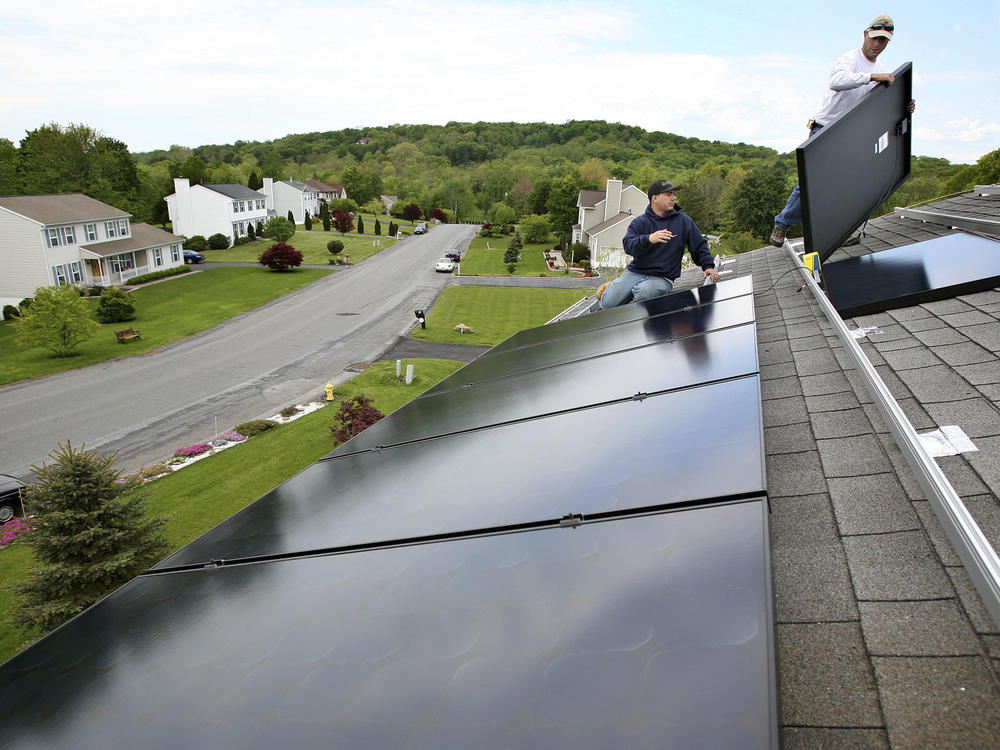Section Branding
Header Content
3 ways the Inflation Reduction Act would pay you to help fight climate change
Primary Content
Updated August 13, 2022 at 2:56 PM ET
Money in the Inflation Reduction Act would make it cheaper for Americans to curb their own climate-warming emissions.
While most of the bill's climate benefits would come from incentivizing major shifts, such as building more wind and solar power, individual choices can add up when undertaken on a large scale.
Here's what you need to know about the bill — which passed the House on Friday and now heads to President Biden's desk for signature — and the three ways it would pay consumers to make greener choices.
Money for efficient electric appliances - and the home upgrades needed to support them
The first home benefit Americans would see is a tax credit for energy efficiency upgrades.
The Inflation Reduction Act calls for reviving a credit that ended last year, making it retroactive for all of 2022 and extending it for a more than a decade. Homeowners who front the cost of energy efficiency improvements, from new doors and windows to more efficient appliances, would be able to claim up to $1,200 a year or 30% of the total cost at tax time.
Down the road, the bill would also set aside more than $8 billion for two rebate programs, aimed at lower- and middle-income households. One would incentivize replacing old appliances with new energy efficient ones, as well as the home upgrades necessary to support them; and another to cut down on energy wasted at home. But those will take time to set up because states must apply for the money and set up systems to implement the rebtes, according to Lowell Ungar, director of federal policy with the American Council for an Energy-Efficient Economy (ACEEE), a nonprofit research organization.
Once that happens, the language in the bill allows for the rebates to take effect at the point of sale.
"The rebate actually means a discount," says Jamal Lewis, director of Policy Partnerships and Equitable Electrification at Rewiring America. Buyers who make 80% or less of the area median income can access the most money, while those making up to 150% of area median income see a smaller benefit.
These rebates are:
- Up to $1,750 for a heat pump water heater.
- Up to $8,000 for a heat pump for space heating or cooling.
- Up to $840 for an electric stove, cooktop, range, or oven; or an electric heat pump clothes dryer.
- Up to $4,000 for a breaker box upgrade.
- Up to $1,600 for insulation, air sealing, and ventilation.
- Up to $2,500 for electric wiring.
Once installed, certain appliances like heat pumps are also cheaper to run in most of the United States, according to ACEEE. Electric appliances, unlike fossil fuel-powered ones, can also switch to run on renewable energy as more wind and solar power are added to the grid. Simply put, "it's a cleaner, better approach" to home energy, Ungar says.
The Act would also create a second rebate program, which would pay households between $2,000 and $8,000 for undertaking holistic upgrades which significantly lower their energy waste, such as new insulation or air sealing.
Money for residential solar panels and energy storage
For homeowners looking to capture renewable energy themselves, the Act would bulk up existing tax credits for residential solar, and offer them as well for home energy storage systems, basically giant batteries.
Taken together, these measures would reduce a building's draw on the electric grid during peak use, for example, when everyone is running their air conditioners during a heat wave.
"It really strengthens the grid for everybody," says Abigail Ross Hopper, president of the Solar Energy Industries Association.
Homeowners could get up to 30% of the cost of home solar back at tax time, retroactive to the beginning of 2022 and running through 2032, with the amount tapering until the end of 2034. The same incentive would apply to storage.
Electric vehicle tax credits aims to help low- and middle-income buyers, but excludes many vehicles
Experts say the bill's electric vehicle tax credits - up to $7,500 for a new EV and $4,000 for a used one - are a mixed bag.
Some measures would democratize who can buy an EV, according to John Helveston, an assistant professor at George Washington University who studies EV markets. Eligible buyers can't make more than $300,000/year on a jointly filed tax return when claiming the credit for a new EV, and the money cannot apply to a car that sells for more than $55,000, or truck/SUV/van priced higher than $80,000, a step that excludes luxury vehicles from the tax credit scheme.
"It's steering everything towards making more affordable, more accessible EVs for the mass market. And that's the direction we need to be going," says Helveston.
The credits could also be transferred to car dealers, in order to apply at the time of sale.
But half of the tax credit amount is tied to gradually increasing requirements that critical minerals used to make EV batteries come from North America or the U.S.'s free trade partners, something manufacturers say is difficult to impossible right now.
"While we work to unlock supplies of critical minerals and ramp up battery production at home, we can't currently meet the demand for these materials on our own," wrote John Bozzella, president and CEO of the Alliance for Automotive Innovation, in a statement on the Act.
His group estimated that the language in the bill would exclude many models from qualifying, and that none could qualify for the full $7,500 once the mineral requirements kick in.
However, consumers should not despair, says Helveston, since the other half of the tax credit should be accessible for at least some vehicles.
"It's not all or nothing," he says.
Copyright 2022 NPR. To see more, visit https://www.npr.org.
Bottom Content




